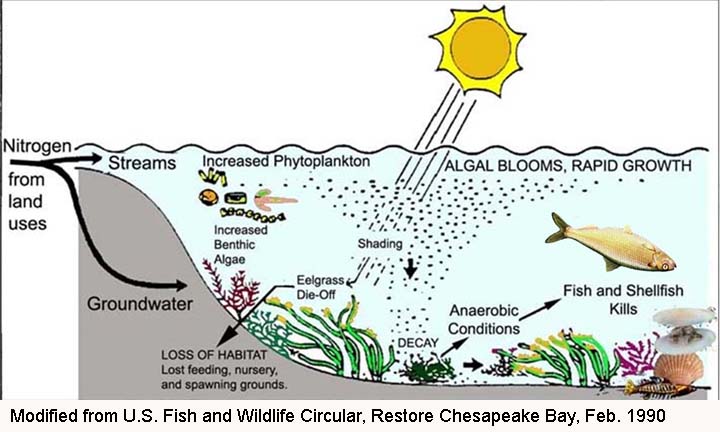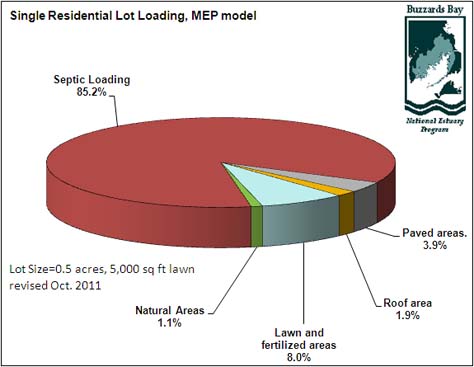The Problem
Impairments to water quality and living resources in coastal embayments caused by excessive nitrogen inputs to Buzzards Bay are one of the most pressing issues identified in the Buzzards Bay CCMP. Some freshwater systems are similarly impaired by excessive phosphorus inputs.
Nitrogen, the primary nutrient of concern in marine waters such as Buzzards Bay, is essential for the proper growth and reproduction of individual organisms and, consequently, for the general productivity of the bay. In nature, nitrogen occurs in many forms (e.g., ammonia, nitrates). The addition of excessive amounts of nitrogen (also called "nutrient enrichment" or "nitrogen loading"), to coastal waters results in eutrophication and a general decline in the health of coastal ecosystems.
In general, excessive nutrient inputs can result in increased growth of microalgae (such as phytoplankton) and macroalgae (seaweeds), which in turn changes the distribution and abundance of species present and in food web relationships. For example, increased turbidity from phytoplankton growth prevents sunlight from reaching submerged vegetation like eelgrass, and beds of eelgrass begin to disappear. Because eelgrass beds are a valuable habitat and nursery for many organisms, the loss of this community can cause shifts in many populations of animals. Excessive algal growth, coupled with decay of accumulated algae, may result in the depletion of oxygen in the water. Depressed oxygen concentrations (anoxia or hypoxia) can lead to fish kills and death of sensitive benthic organisms. These events are represented in the figure below.

Coastal embayments receive nitrogen from a variety of sources including onsite wastewater systems (generally called septic systems), centralized wastewater treatment facilities, atmospheric inputs, and fertilizers used on lawns, golf courses, and agricultural areas. The nitrogen from these sources is conveyed to the bay by effluent outfalls, streams and rivers, overland runoff, and groundwater that drains from the land. The relative importance of these sources depends on the specific land use within each drainage subbasin. In many embayment watersheds, wastewater discharges from onsite waster systems ("septic systems") are often the largest source.
Nitrogen total maximum daily load (TMDL) studies have not been completed for all embayments in Buzzards Bay, but impairments are apparent in all the somewhat less well-flushed embayments that fringe Buzzards Bay. Loss of eelgrass beds, accumulation of benthic algae smothering shellfish beds, and low oxygen concentrations and resulting fish kills are among the impacts that must be remedied. Elimination of excessive nitrogen loads will ensure that all designated uses for those embayments are met. While state and federal agencies regulate permitted discharges like outfall pipes, some sources of pollution like cumulative loadings from septic systems are difficult to regulate. Solutions typically focus on municipal sewer expansion or nitrogen removing onsite systems, both of which have high costs.

Nitrogen loading pie chart for residential development based on average MEP model assumptions, values rounded to nearest percent. The septic loading rates used in this pie chart are comparable to the MEP's parcel specific estimates for the Wareham River estuary watershed. The MEP wastewater loading rates are typically based on parcel specific water use. Got to our nitrogen loading assumptions page to see examples of actual MEP residential wastewater loading rates.
